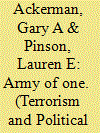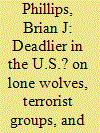|
|
|
Sort Order |
|
|
|
Items / Page
|
|
|
|
|
|
|
| Srl | Item |
| 1 |
ID:
132371


|
|
|
|
|
| Publication |
2014.
|
| Summary/Abstract |
In recent years, much of the literature on terrorist pursuits and use of unconventional weapons has focused on al-Qaeda and other Islamic extremist groups. Some scholars posit lone actors may differ from organizations when it comes to the observation that larger organizations are more likely to engage in chemical, biological, radiological, and nuclear (CBRN) activity, but leave this as an open question because of a prior lack of data on lone actors. Furthermore, new technologies and expanding networks may also spawn more deleterious lone actors, including what have been referred to as "super-empowered individuals." This article utilizes the Profiles of Incidents Involving CBRN by Non-State Actors Dataset and the Radiological and Nuclear Non-State Actors Database to illustrate the characteristics of CBRN pursuit by lone wolves and autonomous cells over time. Initial findings confirm the general perceptions that, historically, lone actors have engaged in cruder, smaller scale, and less frequent CBRN plots and attacks than their formal terrorist organization counterparts, but suggest that such actors do present a genuine threat, at least in terms of the potential for mass disruption. Additionally, while they share several similarities with more formal organizations, lone actors and autonomous cells tend to be motivated less by collective religious or ethno-nationalist concerns than larger organizations, focusing more on narrow or solipsistic drivers. Lone actors and autonomous cells also appear to largely calibrate their CBRN ambitions to their capabilities and their CBRN actions tend to receive better media coverage than formal terrorist organizations.
|
|
|
|
|
|
|
|
|
|
|
|
|
|
|
|
| 2 |
ID:
152885


|
|
|
|
|
| Summary/Abstract |
Scholars, politicians, and pundits increasingly suggest lone wolf terrorists are substantial threats, but we know little about how dangerous these actors are—especially relative to other terrorist actors. How deadly are lone actor terrorists? A growing body of empirical research focuses on terrorist organizations, but similar work on lone actors is sparse. Furthermore, attempts to explicitly compare these or other types of terrorist actors are almost non-existent. This article considers theoretical arguments for why lone wolves ought to be especially lethal. However, it presents an argument for why terrorist groups should generally be more lethal. This argument is conditional upon the environment in which actors operate. Lone wolves should only be more deadly in states with especially strong counterterrorism capacity. The article uses data on terrorist attacks in fifteen developed countries, 1970–2010, to compare the lethality of terrorist acts. Around the world, attacks by organizations tend to be far more lethal than attacks by other actors. In the United States, however, lone wolves are generally the more lethal terrorist actors. This is argued to be because the robust counterterrorism capacity makes organized terrorism more difficult to accomplish.
|
|
|
|
|
|
|
|
|
|
|
|
|
|
|
|
|
|
|
|
|